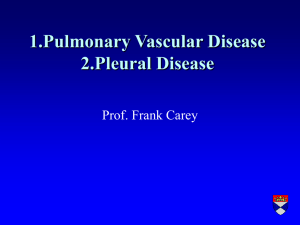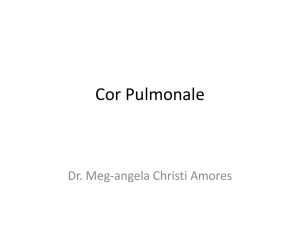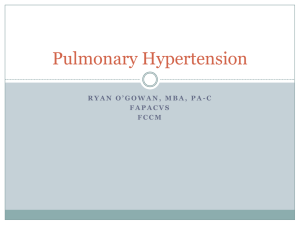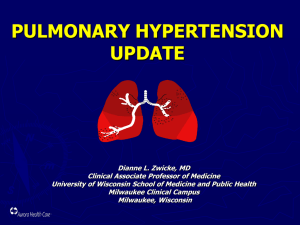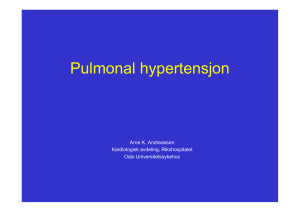Pulmonary Hypertension - The 1st Kuwait
advertisement
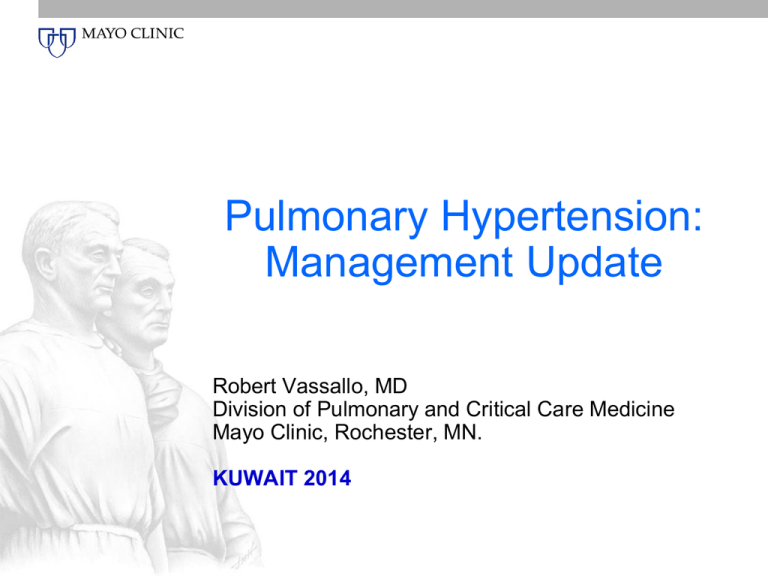
Pulmonary Hypertension: Management Update Robert Vassallo, MD Division of Pulmonary and Critical Care Medicine Mayo Clinic, Rochester, MN. KUWAIT 2014 Disclosures • I have nothing to disclose with respect to this presentation. Key objectives of this presentation • Review WHO updated classification of pulmonary hypertension. • Review diagnostic approach and caveats with testing for pulmonary hypertension. • Outline a clinical rationale for the management of pulmonary hypertension. • Discuss situations when expert opinion and referral to specialized centers may be necessary. Pulmonary Hypertension Concept… …progressive increase in the blood pressure in the pulmonary vascular bed Consequence… …right heart failure and death Criteria for Pulmonary Hypertension • Mean Pulmonary Artery Pressure MPAP > 25 mmHg at rest with pulmonary capillary wedge pressure ≤15 mm Hg 4th World Symposium on Pulmonary Hypertension, Dana Point, CA 2008 Potential sites to induce Pulmonary Hypertension Pre-capillary Post-capillary Updated Clinical Classification of Pulmonary Hypertension 1. Pulmonary arterial hypertension (PAH) 1. idiopathic (“primary pulmonary hypertension”) 2. secondary to systemic disorders 2. Pulmonary hypertension due to left heart disease (pulmonary venous hypertension) 3. Pulmonary hypertension associated with respiratory disease and/or hypoxia 1. COPD, Interstitial lung disease, OSA 4. Chronic thromboembolic/embolic pulmonary hypertension 5. Pulmonary hypertension from unclear mechanisms Journal of the American College of Cardiology Vol. 62, No. 25, Suppl D, 2013 Mean pulmonary artery pressure and cardiac output relationship 90 Severe Mild to moderate 60 Mean PA pressure Normal 30 0 REST 0 EXCERCISE 5 10 15 Cardiac Output [L/min] 20 Signs and symptoms of Pulmonary Hypertension • Symptoms and signs are usually not specific; delay in diagnosis very common. • Early – dyspnea with activity. • Late symptoms: • • • • syncope chest pain / chest pressure leg edema (signs of right heart failure) abnormal findings on chest X ray or ECG Diagnostic studies: Chest radiography Radiographic findings are subtle and often missed ECG abnormalities • • • • Right heart strain (RVH and RA enlargement) Non-specific Right axis deviation ST depression and T wave inversion V1-V3 Screening for pulmonary hypertension • There is no perfect screening tool. • Transthoracic echocardiography • Goals: • 1. determine right ventricular size and systolic function • 2. estimate right ventricular systolic pressure Diagnostic testing: Trans-thoracic echocardiography PASP = (4 x [TRV]2) + RAP LA RA Echocardiography uses Doppler ultrasound to estimate the pulmonary artery systolic pressure LV RV Echo transducer CP900234-1 Pulmonary hypertension diagnosis via right heart catheterization From Mayo Clinic Right Heart Catheterization Training Manual – Cardiology Rotation Clinical approach to suspect pulmonary hypertension • If the echocardiogram suggests the presence of pulmonary hypertension • 1. perform careful evaluation for secondary causes • 2. consider whether you should proceed to right heart catheterization Once you have identified pulmonary hypertension, look for causes 1. Pulmonary arterial hypertension (PAH) 1. idiopathic (“primary pulmonary hypertension”) 2. secondary to systemic disorders 2. Pulmonary hypertension due to left heart disease (pulmonary venous hypertension) 3. Pulmonary hypertension associated with respiratory disease and/or hypoxia 1. COPD, Interstitial lung disease, OSA 4. Chronic thromboembolic/embolic pulmonary hypertension 5. Pulmonary hypertension from unclear mechanisms Journal of the American College of Cardiology Vol. 62, No. 25, Suppl D, 2013 Once pulmonary hypertension is detected, look for causes! European Heart Journal (2009) 30, 2493–2537 History and Exam LFT, CBC Autoimmune screen Overnight oximetry Echocardiography Chest CT V/Q scan PFT HIV serology Other testing as suggested by H&P European Heart Journal (2009) 30, 2493–2537 PAH (Group 1) Medication Options Mild 25 <MPAP< 35 Moderate Severe 35 <MPAP< 50 MPAP> 50 • Ca++ Channel Blocker X • Endothelin antagonist X X • PDE-5 inhibitor X X • Prostanoids • Inhaled iloprost • SQ treprostinil • IV epoprostenol X X X X X X X X Group 1: “Primary” pulmonary arterial hypertension • Remember PAH (Group 1) and PH (Groups 2-5) are different entities • PAH is a progressive disease with a 50% survival at 2.8 years • Can lead to sudden death • Often affects young adults: mean age 45 years • Rarely familial Group 1: Secondary pulmonary artery hypertension • Collagen vascular disease • scleroderma • Systemic lupus erythematosus • Liver disease • Congenital heart • Drugs/toxins • HIV infection Therapy • • • • Treat any underlying disease. Treat cardiac disease (left sided). Treat lung disease and hypoxemia. Treat obstructive sleep apnea or any associated sleep disorder. • Treat thromboembolic disease. • Remember: Groups 2-5 are managed differently and vasodilator therapy is NOT recommended. Intravenous Vasodilators Pulmonary Arterial Respiratory Disease Pulmonary Venous Increased Shunt Pulmonary Edema Adjunctive therapy • Salt restriction. • Diuretics as needed. • Oxygen at rest or with activity. • Flu and pneumococcal vaccination. • Digoxin ? Role if any. • Anticoagulation ? Group 1 PAH therapy Drug of choice? • Right heart catheterization vasodilator “challenge” • 20% acute drop in MPAP and PVR? ...begin with ca++ channel blocker Right Heart Catheterization and Vasodilator Trial Acute Responder Non-Responder NYHA II-IV Calcium Channel Blocker Vasodilator therapy ERA or PDE5-inh or prostacyclin analog Not Improved Involve a specialist with expertise Consider combination therapy Transplant Improved Calcium Channel Blockers • PAH therapy is based on severity of disease as determined by right heart catheterization and responsiveness to vasoactivity testing. • Although not FDA approved for the treatment of PAH, CCBs commonly used are nifedipine, diltiazem, and amlodipine. • All agents are titrated to clinical effect. Objective measures to monitor therapy…every 3-6 months • 6 minute walk (goal > 300 meters) • NT-ProBNP (Brain Naturetic Peptide) • Sequential echocardiography • Other studies depending on context …other therapeutic options • If chronic pulmonary emboli… • pulmonary thromboendarterectomy surgery • If all meds fail… • atrial septostomy • organ transplantation • heart-double lung • double lung Riociguat (a stimulator of soluble guanylate cyclase) significantly improved exercise capacity and pulmonary vascular resistance in patients with chronic thromboembolic pulmonary hypertension. N Engl J Med 2013;369:319-29. Final “take home” messages • New onset exertional dyspnea…think of pulmonary hypertension. • Screen by Transthoracic Doppler Echo but make sure you tell the cardiologist that you are thinking of PH! • Definitive diagnosis by right heart catheterization. • Several pharmacologic options now available: selection a function of PAH severity, expertise, cost assessment, and other factors. • Pregnancy may cause significant challenges. • PH patients are increasingly older with potential multiple ongoing diagnoses. Thank you so much for the invitation.


